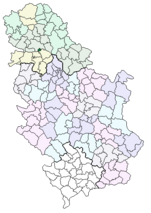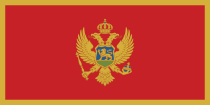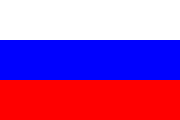Sremski Karlovci
| Сремски Карловци Sremski Karlovci |
|||
|
|||
 |
|||
| Coordinates: | |||
|---|---|---|---|
| Country | Serbia | ||
| District | South Bačka | ||
| Settlements | 1 | ||
| Government | |||
| - Mayor | Rajko Marinković (G17+) | ||
| Area [1] | |||
| - Municipality | 51 km² (19.7 sq mi) | ||
| Population (2002 census)[2] | |||
| - Total | 8,839 | ||
| - Municipality | 8,839 | ||
| Time zone | CET (UTC+1) | ||
| - Summer (DST) | CEST (UTC+2) | ||
| Postal code | 21205 | ||
| Car plates | NS | ||
| Area code | +381 21 | ||
| Website: http://www.sremski-karlovci.org.yu | |||


Sremski Karlovci (Сремски Карловци) is a town and municipality in the autonomous province of Vojvodina, Serbia, situated on the bank of the river Danube, 8 km from Novi Sad. In 2002, its population was 8,839.
Contents |
Name
In Serbian, the town is known as Sremski Karlovci (Сремски Карловци), in German as Karlowitz or Carlowitz, in Croatian as Srijemski Karlovci, in Hungarian as Karlóca, and in Turkish as Karlofça. Former Serbian name used for the town was Karlovci (Карловци) - it is used today as well, but unofficially.
Geography
The town is situated in the geographical region of Srem (hence the name), but it is part of the South Bačka District.
History
In ancient times, a small Roman fortress existed at this location. The town was first mentioned in historical documents in 1308 with the name Karom. The fortress of Karom was built on the ruins of the ancient Roman one. Until 1521, the Karom was a possession of the Hungarian noble families, of which the most well known were Báthory and Morović.
Turkish military commander Bali-beg conquered Karom in 1521, and in the next 170 years, the town was part of the Ottoman Empire. The Slavic name for the town - Karlovci, was first recorded in 1532/33. During the Ottoman rule, the town was mostly populated by Serbs, with the smaller part of population composed of Turks. According to the Ottoman defters from 1545, the population of Karlovci numbered 547 Christian (Serb) houses, thus it was the largest city with Serb majority in the whole Ottoman Empire. The city also had three Orthodox churches and a monastery.
Between November 16, 1698, and January 26, 1699, the town of Karlovci was the site of a congress that ended the hostilities between the Ottoman Empire and the Holy League, a coalition of various European powers including Habsburg Monarchy, Poland, Venice and Russia; the congress produced the Treaty of Karlowitz. It was the first time a round table was used in international politics.
After this peace treaty, the town was part of the Habsburg Monarchy and was included into the Military Frontier. According to the 1702 data, the population of the town was composed of 215 Orthodox and 13 Catholic houses, while according to the 1753 data, the population of the town numbered 3,843 people, of which 3,110 were ethnic Serbs.
The town was also the spiritual, political and cultural centre of the Serbs in the Habsburg Monarchy. The Metropolitan of the Serb Orthodox Church resided in the town. To this day, the Serb Orthodox Patriarch retains the title of Metropolitan of Karlovci. The town also featured the earliest Serb (and Slavic in general) grammar school (Serbian: gimnazija/гимназија, French: lycée) founded on August 3, 1791. Three years after this, an Orthodox seminary was also founded in the town. It was the second oldest Orthodox seminary in the World (After the Spiritual Academy in Kiev), and it operates to this day.
At the Serb National Assembly in Karlovci in May, 1848, Serbs declared the unification of the regions of Srem, Banat, Bačka, and Baranja (including parts of the Military Frontier) into the province of Serbian Vojvodina. The first capital of Serbian Vojvodina was in Karlovci, until it was latter moved to Zemun, Veliki Bečkerek, and Temišvar. In the same time the title of the Orthodox Metropolitan of Karlovci was raised to that of the Patriarch, which thus established an Orthodox Patriarchate of Karlovci that existed until 1920 when it was joined with Metropolitanate of Belgrade to form the new Patriarchate of Serbia.
When Serbian Vojvodina was in 1849 transformed into the new province named Vojvodina of Serbia and Tamiš Banat, Karlovci were not included into this province, but were returned under the administration of the Military Frontier (Slavonian Krajina). With the abolishment of the Military Frontier in 1881, the town was included into Croatia-Slavonia, the autonomous kingdom within Austria-Hungary.
In 1918, the town became part of the Kingdom of Serbs, Croats and Slovenes. In the 1920s, it became the headquarters of Russian White émigrés of General Wrangel whose monument remains to this day. It was also home to the Holy Synod of the Russian Orthodox Church Outside Russia.
Between 1929 and 1941, the town was part of Danube Banovina, a province of the Kingdom of Yugoslavia. During World War 2 (1941-1944), the town was occupied by the Axis Powers and it was attached to the Independent State of Croatia. During that time its name was changed to Hrvatski Karlovci. Since the end of the war, the town has been part of the Autonomous Province of Vojvodina.
Between 1980 and 1989, Sremski Karlovci was one of the seven municipalities of Novi Sad City. Today, the municipality is not part of Novi Sad City, but a separate administrative unit.
Historical population of the town
- 1961: 6,390
- 1971: 7,040
- 1981: 7,547
- 1991: 7,534
Ethnic groups (2002 census)


The population of the Sremski Karlovci municipality:
- Serbs (75.39%)
- Croats (8.51%)
- Yugoslavs (2.87%)
- Hungarians (2.43%)
- Montenegrins (1%)
Politics
Until 1989, Sremski Karlovci was part of the City of Novi Sad, and Petrovaradin municipality. After Novi Sad merged five its municipalities into one Novi Sad municipality, Sremski Karlovci held a referendum to separate from Novi Sad, and established its own municipality. Aldo Sremski Karlovci are located in Syrmia region, because of its close proximity to Novi Sad, municipality is part of South Bačka District, and not a part of Srem District.
On Serbian local elections, 2008, held on May 11, 2008; Sremski Karlovci elected a new municipality parliament, ending a rule of Serbian Radical Party in the town. Rajko Marinković, from G17 Plus (part of For a European Sremski Karlovci coalition), was elected as a new mayor in municipality parliament.[3]
| Parties | Votes | % | Seats | +/- |
|---|---|---|---|---|
| For a European Sremski Karlovci – Boris Tadić (За европске Сремске Карловце - Борис Тадић) | 2,360 | 49.4 | 15 | ▲10 |
| We own Karlovci-Branislav Pop Jovanov (Наши су Карловци – Бранислав Поп-Јованов и нестраначки грађани Карловаца) | 274 | 5.7 | 1 | ▲1 |
| Serbian Radical Party (Српска Радикална странка) | 1,098 | 23.0 | 6 | ▬0 |
| Together for Vojvodina (Заједно за Војводину) | 228 | 4.8 | 0 | ▼2 |
| Socialist Party of Serbia (SPS) – Party of United Pensioners of Serbia (PUPS) (Социјалистичка партија Србије (СПС) – Партија уједињених пензионера Србије (ПУПС)) | 293 | 6.1 | 1 | ▲1 |
| Karlovac initiative (Карловачка иницијатива) | 273 | 5.6 | 1 | ▲1 |
| Democratic Party of Serbia (DSS) (Демократска странка Србије) | 253 | 5.3 | 1 | ▼1 |
| Total (turnout 59.7% or 4,859 out of 8,183)[4][5] | 4,859 | 100% | 25 | |
Schools
- Gymnasium of Karlovci (Karlovačka gimnazija)
- Clerical High School of Saint Arsenije
Twin cities
 Eymet, France
Eymet, France Tivat, Montenegro (2007)
Tivat, Montenegro (2007) Novocherkassk, Russia
Novocherkassk, Russia Sergiev Posad, Russia
Sergiev Posad, Russia
References
- Milorad Grujić, Vodič kroz Novi Sad i okolinu, Novi Sad, 2004.
- Slobodan Ćurčić, Broj stanovnika Vojvodine, Novi Sad, 1996.
See also
- Buildings and structures in Sremski Karlovci
- Fruška Gora
- Syrmia
- List of places in Serbia
- List of cities, towns and villages in Vojvodina
References
- ↑ "Municipalities of Serbia, 2006". Statistical Office of the Republic of Serbia.
- ↑ (in Serbian)Popis stanovništva, domaćinstava i Stanova 2002. Knjiga 1: Nacionalna ili etnička pripadnost po naseljima. Statistical Office of the Republic of Serbia. 2003. ISBN 86-84443-00-09.
- ↑ RTV - Sremski Karlovci - koalicija DS i G17 plus na vlasti (Serbian)
- ↑ CESID results of local election held on May 11, 2008 (Serbian)
- ↑ Municipality official site (Serbian)
External links
- www.sremski-karlovci.org.yu (Official site)
- Sremski Karlovci
- Srem Classified Ads
|
|||||
| Municipalities and cities of Serbia | |||||||||||||||||||
|
|||||||||||||||||||